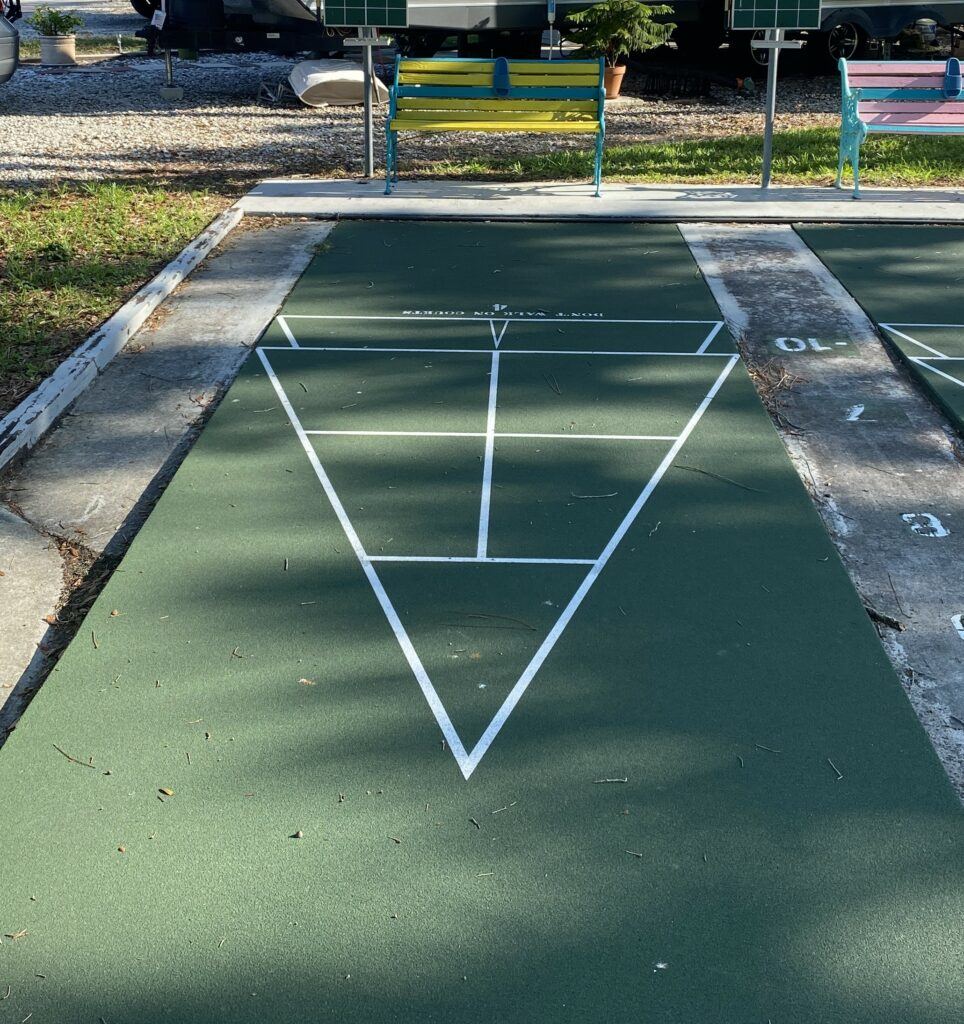
Shuffleboard is a classic game that has been enjoyed by people of all ages for centuries. Known for its blend of skill, strategy, and social interaction, shuffleboard can be played in various settings, from cruise ships, campgrounds, senior centers, and competitive sports venues. In this post, I will give you a look into how shuffleboard is played, the rules of the game, and strategies to help you win.
History and Variations
Shuffleboard has a rich history, dating back to the 15th century in England. Over time, the game has evolved into several variations, including deck shuffleboard, table shuffleboard, and floor shuffleboard. While each variation has unique elements, the basic principles remain consistent across all forms.
Equipment
To play shuffleboard, you need the following equipment:
- A shuffleboard court or table
- Discs or pucks (usually colored to distinguish between players or teams)
- A cue (for deck and floor shuffleboard) or your hands (for table shuffleboard)
Objective
The main objective of shuffleboard is to slide your discs or pucks down the playing surface, aiming to land them in the scoring zones at the opposite end while preventing your opponent from doing the same. The scoring zones are typically marked with different point values.
 | Check out my selection of canvas prints. The images are printed on premium canvas and then stretched on a wooden frame 1.5” X 1.5” – gallery wrap or 5/8” X 5/8” – museum wrap. Comes with pre-attached wire, mounting hooks, and nails. SHOP NOW |
Setup
- Court/Surface Preparation: Ensure the playing surface is clean and properly maintained. For table shuffleboard, apply silicone spray or shuffleboard powder to ensure smooth sliding of pucks.
- Disc/Puck Selection: Each player or team selects their discs or pucks, typically divided into two colors.
- Starting Position: Players stand at the end of the court or table opposite the scoring zones. In floor and deck shuffleboard, players use a cue to push the discs, while in table shuffleboard, they use their hands.
Gameplay
- Turns: Players take turns sliding their discs/pucks. The player or team that won the coin toss or the previous game usually goes first. It is important to note that if you are playing with 2 players (head to head) both players stand on the same side. If you are playing teams (4 players) 1 member from each team stands on opposite sides.
- Sliding Technique: For table shuffleboard, players slide the puck using their hand, applying a gentle yet firm push to ensure it glides smoothly. For deck and floor shuffleboard, players use a cue to push the disc.
- Scoring Zones: The goal is to land the discs/pucks in the marked scoring zones at the opposite end. These zones typically have point values ranging from 1 to 10, with higher points awarded for discs closer to the far end.
- Knocking Opponents’ Discs: Players can strategically aim to knock their opponent’s discs out of scoring zones while trying to place their own in high-scoring areas.
General Rules
- Scoring: Points are scored at the end of each round when all discs have been played. Only discs completely within a scoring zone count for points. If a disc is touching a line, it scores the lower point value.
- Foul Lines: In deck and floor shuffleboard, there are foul lines that the discs must pass to be considered in play. Discs that do not pass the foul line are removed from the court.
- Offensive and Defensive Play: Players can adopt offensive strategies by aiming for high-scoring zones or defensive strategies by blocking opponents or knocking their discs out of play.
- Winning: The game can be played to a predetermined number of points (commonly 15, 21, or 50 points) or to a set number of rounds, with the player or team having the highest score at the end declared the winner.

Table Shuffleboard-Specific Rules
- Hand Usage: Players must use their hands to slide the pucks.
- Lagging for Hammer: The initial order of play is often determined by “lagging for hammer,” where players slide a puck to the opposite end, and the player whose puck lands closest to the edge gets the last turn (hammer).
- Shooting Order: Players alternate turns, sliding one puck at a time.
Strategies to Win at Shuffleboard
- Control Your Strength: The force you apply when sliding the disc or puck is crucial. Too much force may send it off the end, while too little may not reach the scoring zone.
- Aim for High-Value Zones: Focus on landing your discs/pucks in high-scoring zones, but avoid overly risky shots that might leave you vulnerable.
- Knock Out Opponents’ Discs: Use your turns to strategically knock your opponent’s discs out of scoring zones or into lower-value areas.
- Block and Protect: Place your discs in positions that block your opponent’s access to high-scoring zones or protect your own high-scoring discs.
- Practice Precision: Regular practice will help improve your aim and control, essential for placing discs accurately in scoring zones.
- Observe and Adapt: Pay attention to your opponent’s strategy and adapt your play accordingly. If they are aggressive, you might need to focus more on defense.
Final Thoughts
Shuffleboard is a timeless game that offers a perfect mix of skill, strategy, and enjoyment. Whether you’re playing on a cruise ship deck, a bar’s shuffleboard table, or a community center’s floor court, understanding the rules and mastering gameplay techniques will enhance your experience. Remember, the key to winning lies in precision, control, and strategic thinking. So, grab your discs or pucks, take your stance, and slide your way to victory! Enjoy the game and the camaraderie it brings!
Did you enjoy this post? Do you want to know when the next post comes out? Consider subscribing. I only send update emails once a week, usually on Friday. Try it out. You can unsubscribe at any time.
